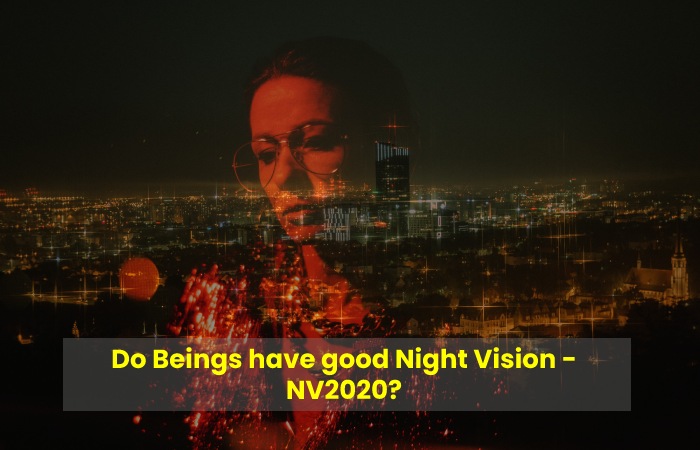Night vision – NV2020 users can take some images in complete darkness and have better seeing in dimly lit areas. The most popular uses for nighttime technology are flying or driving at night, nighttime security and surveillance, observing wildlife, monitoring sleep labs, and search and rescue operations. Additionally, night vision is frequently utilised in the military and for leisure activities like night hiking and home video cameras.
Table of Contents
What is Night Vision – NV2020?
Night vision, also named scotopic vision, is your natural skill to see in the dim. It kicks in when different components, particularly your pupils and retinas, work composed inside your eyes. It can come in attractive handy when you need it.
How your Eyes Adjust to the Darkness
In a dark situation, your eyes gather as much light as possible. They do this by opening the acolytes wide and allowing your eyes to catch as many rough plans and shapes as possible.
In a happier setting, your pupils shrink back down since they have all the brightness they essential to see comfortably. To observe this firsthand, stand in front of a dark room mirror and ask someone to turn on the lights. If you’re fast sufficient, you’ll see your pupils rapidly shrinking.
This automatic procedure is one reason you have scotopic vision, but it doesn’t show the entire picture. First, you must look at the microscopic cells in the back of your eyes. There are lots of rod-shaped and cone-shaped cells along every eye’s cornea. These rods and cones are essential for eyesight.
Rods and cones each react a little otherwise to varying types of light. So when the right light strikes them, they send tiny impulses along your optic nerve and into the back of your brain. It is how vision happens. While cones are countless at registering bright lights, colours and fine details, they’re not so helpful in helping you see in the dark — that’s where your bars come in.
Rods shine in peripheral vision and are much more subtle to light photons, which makes them very helpful in low-light settings. Without rods scattered across your retinas, any darkness would be virtually blinding. But there’s a catch: Rods can’t process colour. It is why your night vision isn’t very colourful and often appears in black and white. Look everywhere next time you’re lying in a darkened bedroom. Not very lively, is it?
Do Beings have good Night Vision – NV2020?

The last period you woke up in the night, were you frustrated by just how little you could see?
Unfortunately, one of the disadvantages to being a human is that night vision isn’t countless. At least likened to the rest of the animal kingdom. And regulating the darkness certainly isn’t a quick process for a human. Reaching your all-out level of night vision is nearly painfully slow. It takings your eyes 5 to 8 minutes to start adjusting to the darkness, but they don’t reach maximum adjustment until you’ve been in the dark for about 40 minutes.
But there’s a good reason for this: Humans are primarily daytime. So they make up for their lack of night vision in vibrant colours and difference during the day. Animals at nighttime or spend more time in the dark tend to have better night vision. In addition, cats and dogs, along with cows, horses and deer, have an iridescent coating behind the retina that boosts their scotopic image. This feature remains called a tapetum lucidum, giving their eyes that colourful, reflective glare at night.
Artificial Night Vision – NV2020
The visible light makes up only a tiny helping of the electromagnetic spectrum, a scale that comprises every type of radiation. Thermal cameras focus on radiation just past the visible scale. Whatever you feel as heat usually qualifies as electromagnetic radiation. Current cameras can function in total darkness but only in the attendance of objects that contain or emit heat. Nevertheless, they remain commonly used for seeing people or animals at night since visible heat from the body creates a stark contrast to a cooler, darker background.
Images or videos taken by thermal cameras must remain processed since infrared energy is invisible to the human eye. However, you may see what appears to be glowing things once the camera transforms these infrared photos.
Like your natural eyes, the more conventional “green” night vision needs light. This technology somewhat brightens the black image so you can see it more clearly and in greater detail. Compared to grayscale or black and white, a human’s natural night vision would perceive that green allows us to see the finished output more clearly.
Possible After the Nanoparticle Breakthrough
In visual physiology, adaptation is the ability of the eye’s retina to adjust to various levels of light. Natural night vision, or scotopic vision, is the ability to see under low-light conditions. In humans, rod cells are exclusively responsible for night vision, as cone cells can only function at higher illumination levels.[1] Night vision – NV2020 is lower quality than day vision because it is limited in resolution, and colours cannot remain discerned; only shades of grey remain seen.
To transition from day to night vision, humans must undergo a dark adaptation period of up to two hours. Each eye adjusts from a high to a low luminescence “setting”, increasing sensitivity hugely by many orders of magnitude. This adaptation period is different between rod and cone cells and results from the regeneration of photopigments to increase retinal sensitivity. Light adaptation, in contrast, works very quickly, within seconds.
Conclusion
NV2020 – Difficulty sighted at night is a common problem that affects millions of Americans. So common that many people learn how to live with it somewhat than trying to do something about it. The problem with treating night vision loss as an inconvenience or annoyance is that we may likely ignore a more serious problem. Loss of night vision is often the consequence of an underlying condition and a danger to ourselves and others.
Also Read: Do Clear Cases Turn Yellow? Why do People use Clear Phone Cases?
Related posts
Featured Posts
Vanessa Bryant: Who is She? Vanessa Bryant Net Worth 2021
Vanessa Bryant Net Worth – The mother nationality of Vanessa is the American Vanessa Cornejo Urbieta. However, she was born…
What exactly is Google App Console? – Smart Tech Crunch – 2022
You may expand your Google Play company by using the Google Play App Console to publish your applications and games….


